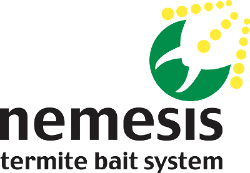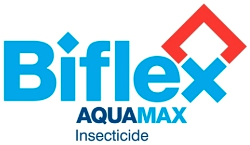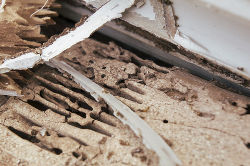| Natraspray Pest Control | |||||||
|
|||||||
Termite Protection
|
|||||||
| Click here for your closest Natraspray | |||||||
NemesisWhat is Nemesis?Nemesis is an Australian termite bait system designed to attract and eliminate termite colonies in a safe non invasive way. It uses an insect growth regulator (IGR), Chlorfluazuron, as the active constituent in the Nemesis bait. Active termites feed on the highly attractive bait food source and trans locate the IGR to other members of the colony, at levels undetectable by those termites, until the colony collapses. Nemesis termite bait is a registered product under the requirements of legislation administered by the Australian Pesticides and Vetinary Medicines Authority. This termite pest control system uses a number of unique stations for in ground and above ground interception of active termites. 
How Does Nemesis Work?First a professional pest manager will inspect your home for termites, and if they are found or if the risk of possible activity is high, the Nemesis termite bait system will be recommended. If termites are found, Nemesis above ground stations are placed directly over the active areas; this engages the termites and results in faster colony elimination. Otherwise, Nemesis in ground stations are deployed around the perimeter of your home. Termite attractive timber inserts are placed inside these external stations and are monitored on a regular basis for termite activity. Once the termites have entered the Nemesis stations and are feeding on the timber, the bait is placed into the station. The Termites quickly start to feed on the Nemesis bait, taking it back to the nest. The Termites cannot detect that the bait is slowly affecting their ability to grow and develop, stopping the termite colony being able to reproduce, therefore eliminating the nest. TermidorWhat is Termidor?Termidor is owned by BASF based in Mount Olive, New Jersey USA. It is the biggest selling termiticide in the USA and is now used in Australia, Japan, France and most other countries where subterranean termite infestations are a severe economic problem. In fact, Termidor has been used in more than a million homes with safety and effectiveness. 
How Termidor Eliminates TermitesTermidor is applied by licensed pest controllers to soil areas abutting a building in order to eradicate termites as they attempt to gain entry into the building. This provides immediate protection and reduction of risk of on-going expensive structural timber damage from a termite infestation, of a kind not available from alternative termite baiting systems. In addition, termites in contact solely with a lower concentration area, such as, in the out-reaches of a Termidor treated soil area, will not detect it's debilitating effect until a few days later - enough time to routinely transfer the Termidor active ingredient to other termites they contact. This delayed accumulative lethal effect of Termidor, aimed at eliminating the entire colony, is discussed in detail later on. Termidor works quite differently from other Termiticide soil treatment pest control products which are repellents, in effect designed to repel or keep termites away from a treated soil area, rather than killing them. This means any minute gap in the treated soil can be detected and exploited by the termites to gain entry in the building. This is a major short-coming of the old-fashioned termite pest control alternatives, far too often, with financially disastrous consequences. Termites tunneling in higher concentration Termidor treated soil areas abutting the building are killed outright, within a few hours. Termites tunneling in the outer reaches of a Termidor (lower concentration) treated soil area, cannot detect the Termidor chemical which readily sticks to the termites body. These termites remain unaffected for a few days, before sudden death occurs. This delayed lethal effect provides enough time for the Termidor chemical to be transferred back to the central colony nest to infect other termites. The "carrier" termites are able to readily spread the Termidor chemical to other termites during regular physical contact with other termites in the colony, particularly when working together in close proximity, grooming and feeding other termites, a regular function of their daily life. Termites cannot detect the Termidor chemical as it has virtually no odour, taste or smell to the termites. Termites cannibalize or carry away dead termites killed by the Termidor on their bodies, further spreading Termidor's deadly effect to other termite colony members. Long-Term ProtectionAs with any termite pest control program, your property always remains susceptible to future attack from new termite colonies or other established colonies in your area. The good news for the homeowner is that the Termidor soil treatment chemical will remain in place for many years even after the existing attack on your property has been eliminated. In brief, Termidor treated soil acts on an on-going basis to prevent termite entry through a treated soil area into a building or other protected structures. Such a chemical soil barrier under and around the external perimeter of a building is a pretty big target for the foraging termites to hit, rather than scattered bait stations around the building! Term-A-Trac
Termatrac is a breakthrough development in the detection of termites, invented and developed in Australia using technology similar to radar. Termatrac is the answer to detecting termites through timber, plaster board, brick or masonry with no interference to the building material or termite activity. Termatrac emits signals which penetrate the material that is being searched. Any termite activity interrupts the signals and Termatrac relays this information to the operator, allowing them to pinpoint the termites in an instant. The operator can then track the termites back to the entry point and assess the extent of the termite activity without disturbing them. Biflex Chemical BarrierIn protecting against termites, the basic idea is the same in all homes: treat the soil around the house to form a barrier that termites cannot penetrate. Because termites can move through the tiniest cracks in concrete or metal, the barrier must be absolutely continuous. Even the smallest break in the barrier can let termites in. 
This means we've got a lot more to do than just treat around the perimeter of your house. While that takes care of the biggest stretch of the defence we put up, there are lots of other places that need special treatments. Here are the things we do to make sure the barrier is continuous. Not all of the activities are listed will be done as we customize our treatment depending upon the structure treated, termite species and activity, product label restrictions and State laws. In some situations, specialized equipment may be used. Step 1 is a thorough inspection to look for activity, identifying the termite species involved and to note conditions conducive to termite problems. We will also indicate to you that corrective measures we recommend you take in addition to our treatment activities. |
|||||||
| Click here for your closest Natraspray | |||||||
| Welcome Termite Protection Pest Control Testimonials News Locations Contact / Bookings | |||||||
|
Copyright © 2017 - Natraspray Pest Control
|
 Chances are - very little.
In fact, you may not even know you have termites in your home, until it is too late.
Our most important termite species live in underground nests containing up to two million wood eating termites.
That's a lot of hungry mouths that travel fifty meters, or more, in search of food, and your home provides them with a smorgasbord to feast upon.
The trouble is, as the termites travel underground, and enter your home by concealed mud tunnels, you may have no idea they're ready to devour your place.
Chances are - very little.
In fact, you may not even know you have termites in your home, until it is too late.
Our most important termite species live in underground nests containing up to two million wood eating termites.
That's a lot of hungry mouths that travel fifty meters, or more, in search of food, and your home provides them with a smorgasbord to feast upon.
The trouble is, as the termites travel underground, and enter your home by concealed mud tunnels, you may have no idea they're ready to devour your place.
